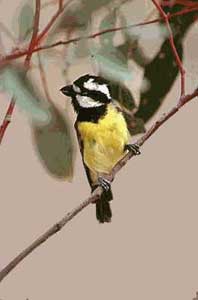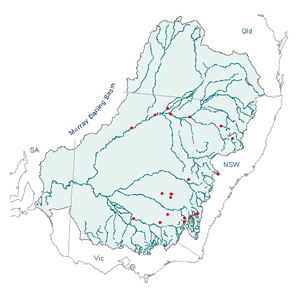Taxon Attribute Profiles

photo: Graeme Chapman
|
Falcunculus frontatus
Crested Shrike-tit
Taxonomy and Ecology
Life Form/Morphology
Falcunculus frontatus is an endemic passerine bird measuring some
17 cm in length. The genus is monotypic and the species is divided into
three isolated forms, sometimes considered full species, all of which
are characterised by bold plumage, large crested head, and stout powerful
bill. The head of the Crested Shrike-tit is striped black and white, with
a broad median crown stripe and black eyelines setting off its otherwise
white cheek patches. The head pattern of females is similar to but less
bold than that of males, and males have a black chin and throat patch,
whereas that of females is olive or olive-brown. Birds of the eastern
race frontatus have dark olive backs and are pale yellow to yellow
beneath; those of the northern race whitei have yellow-olive backs
but are similar to eastern birds below. Individuals of the southwestern
form leucogaster also have yellow-olive backs but below they are
mainly white, with yellow only on the breast, vent, and undertail coverts.

click to enlarge map
|
Distribution
In the east, F. frontatus is found mainly in southeastern Australia,
ranging from southeastern and south-central Queensland through much of
New South Wales (especially in the east) and most of Victoria and into
southeastern South Australia; isolated Queensland populations additionally
occur as far north as the Atherton region (HANZAB 2001; Barrett et al.
2003). There are scattered records of the northern race whitei
from the Top End, Northern Territory, and this race also occurs in the
Kimberley region of Western Australia. The race leucogaster is
confined to southwestern WA. The distribution of the Crested Shrike-tit
in western NSW is very distinctive: the species is widespread in woodlands
along the western slopes of the Great Dividing Range, but further west
is found mainly along the larger rivers, especially the Murray and the
Darling, although it is rarely seen in NSW west of Wentworth (Cooper and
McAllan 1995).
Habitat
All subspecies of F. frontatus occupy eucalypt woodlands and forests.
Populations in the Murray-Darling Basin, especially those to the west,
are strongly associated with the river red gum Eucalyptus camaldulensis.
In this region, the Crested Shrike-tit appears to be reliant on extensive
stands of this species. F. frontatus is rarely found in areas in
which black box E. largiflorens is predominant and river red gums
form only a fringing strip along riverbanks and backwaters. The Shrike-tit
can more easily glean prey from the loose ribbon-like bark of E. camaldulensis
than from the deeply furrowed bark of E. largiflorens (Joseph and
Reid 1981).
Role in community
F. frontatus is largely an insectivore; it also feeds on spiders
and other invertebrates and occasionally takes plant matter such as fruit
or seeds. Insects most often eaten near Armidale, NSW, were Coleoptera,
especially Chrysomelidae (Ford 1985). This species specialises in prising
peeling bark from large branches or tree-trunks and extracting prey from
underneath. It is active at all forest strata, but is typically found
in the sub-canopy or canopy. This species also gleans insects from foliage
and can use its powerful bill to open woody galls of insects. Despite
its bill, the Crested Shrike-tit prefers to forage on gums, stringybarks,
and other trees with flaky ribbon-like bark, rather than those with rough
bark, from which it is more difficult to extract prey items.

photo: Ellis McNamara
|
Reproduction and Establishment
Reproduction
Breeding occurs in the eastern race frontatus from August through
January and 2-3 eggs are laid. The nest is a deep cup or cone woven from
grass fibres and strips of bark, lined with fine strips of bark and grass
and covered outside with filaments of spider webs. The nest is typically
placed in a vertical fork high in a eucalypt tree or sapling, and the
birds trim or nip off leaves in the vicinity of the nest. Two broods are
generally raised. The incubation period is 18-20 days; both sexes incubate
although the female moreso than the male (HANZAB 2001).
Dispersability
The Crested Shrike-tit is a diurnal bird that occupies large territories
during most of the year. The species appears to be resident in most parts
of its range, although local or seasonal movements have been reported
in some areas. For example, F. frontatus has been described as
nomadic in the Inverell, NSW, area (Baldwin 1975), and the species occurs
in Rockhampton, Qld, only in late winter and spring (Longmore 1978). This
species can be found in pairs, in small groups of 3-5 birds (often family
groups of parents and young), and as single individuals. F. frontatus
occasionally joins mixed-species flocks.
Juvenile Period
Young of the Crested Shrike-tit are altricial (completely dependent on
parents) and remain in the nest for some time after hatching. Time from
fledging to independence is some 15-20 days (HANZAB 2001). Juvenal plumage
is typically worn until late summer or early autumn.
Hydrology and Salinity
Flooding Regimes
This species will be affected by differing flooding regimes to the extent
that they change the distribution of river red gums or the abundance of
invertebrates under their bark.
Conservation Status
The eastern subspecies is of least conservation concern, although the
western form leucogaster is near-threatened and the northern form
whitei is endangered (Garnett and Crowley 2000). Populations of
the northern form are severely fragmented, and individuals may now be
at such low density that many local populations are no longer viable.
The western form has declined primarily due to habitat loss, particulary
clearing of habitat for agriculture. Nests of F. frontatus have
been reported to be depredated by cats (Chisholm 1915).
Summary
The Crested Shrike-tit Falcunculus frontatus is closely associated
in much of the Murray Darling Basin with stands of the river red gum Eucalyptus
camaldulensis. Changes in the distribution or abundance of F.
frontatus in the Murray Darling will likely be linked to alterations
in distribution of river red gums or to changes in abundance of their
bark-dwelling invertebrates. Declines of the northern form of this species
may be linked to changes in the frequency of fires, which now occur too
often for insects to become established beneath the bark of gum-barked
trees (Robinson and Woinarski 1992).
References
Baldwin, M. 1975. Birds of Inverell district, NSW. Emu 75:113-120.
Barrett, G., Silcocks, A., Barry, S., Cunningham, R., and R. Poulter.
2003. The new atlas of Australian birds. Royal Australasian Ornithologists
Union, Hawthorn East, VIC.
Chisholm, A. H. 1915. Notes on the Yellow-bellied Shrike-Tit Falcunculus
frontatus. Emu 15:78-85.
Cooper, R. M. and I. A. W. McAllan. 1995. The birds of western New
South Wales: a preliminary atlas. New South Wales Birds Atlassers,
Albury.
Ford, H. A. 1985. The bird community in eucalypt woodland and eucalypt
dieback in the Northern Tablelands of New South Wales. Pp. 333-340 in
Birds of eucalypt forests and woodlands (A. Keast et al., eds.),
Surrey Beatty & Sons Pty and Royal Australasian Ornithologists Union,
Chipping Norton, NSW.
Garnett, S. T., and G. M. Crowley. 2000. The action plan for Australian
birds 2000. Natural Heritage Trust/Environment Australia, Canberra.
HANZAB. 2001. Handbook of Australian, New Zealand and Antarctic birds.
Volume 5: tyrant-flycatchers to chats. Oxford University Press, Melbourne.
Joseph, L. and J. Reid. 1981. The Crested Shrike-tit on the Darling and
Murray Rivers. South Australian Ornithologist 28:157-159.
Longmore, N. W. 1978. Avifauna of the Rockhampton area, Queensland. Sunbird
9:25-53.
Robinson, D., and J. C. Z. Woinarski. 1992. A review of records of the
Northern Shrike-tit Falcunculus frontatus whitei in north western
Australia. South Australian Ornithologist 31:111-117.
|

